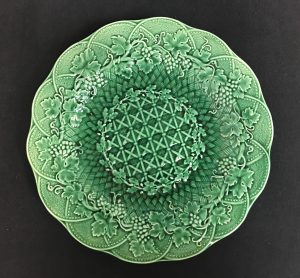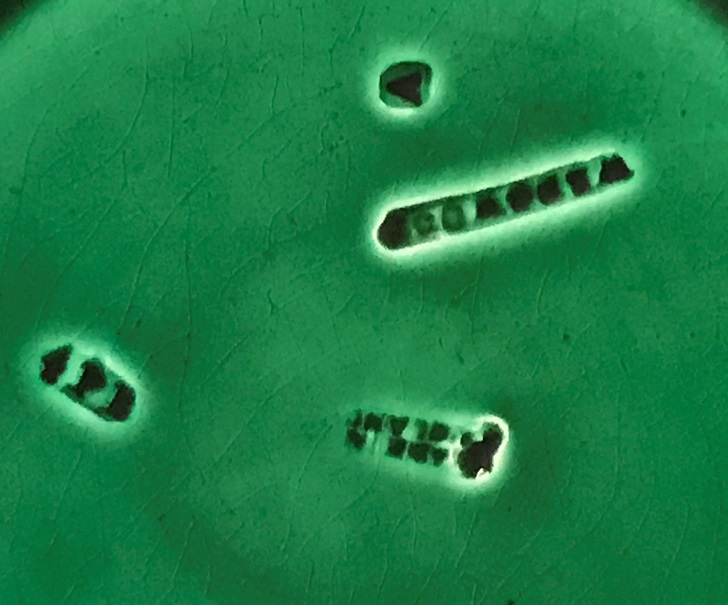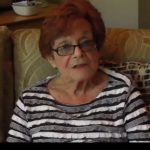From the Archive: Evelyn Sanger Badt’s Majolica Plate Set, c. 1924
 Evelyn Sanger Badt was born in 1912 and died in 1995, at 82.
Evelyn Sanger Badt was born in 1912 and died in 1995, at 82.
She was the daughter of Ike and Mabel Sanger and married Sig Badt. Her father was I. L. Sanger, Son of Lehman Sanger of the famed Sanger Bros. And, she wasn’t the only Evelyn of the Sanger empire. A different Evelyn Sanger, wife of Elihu Sanger, is referenced in They Came to Stay, “The Jews who Built Dallas,” and “Merchant Princes.” However, Evelyn and Sig Badt were both prominent within Jewish Dallas, and Dallas at large. As Rose Biderman remarks, the Sangers are the closest thing Dallas ever had to royalty. Their homes, and those of their extended family, as well as their furnishings, and other belongings were luxurious and statement-making.
Evelyn and Sig’s set of Majolica plates, a wedding gift from Stanley Marcus, are no exception. “Majolica” refers to a style of ceramic wear that originated in Spain and Portugal in the 13th century. Its meaning has since evolved to include a broader range of decorative and functional pottery created in Italy during the Renaissance, in the Victorian era across Europe and the United Kingdom in the late 19th and early 20th centuries. The style generally includes a metal-based enamel glaze (traditionally lead and tin) with elaborate hand-painted designs or a layer of bright, iridescent glaze.
This particular style of “Majolica” follows the tradition of functional pottery with incised, or raised, designs and a layer of bright green, iridescent glaze. This producer is Wedgwood, which originated in the UK in the mid 1700s and began producing Majolica-style pottery around 1860. Wedgwood continued production of Majolica until 1940. With this knowledge, and additional information provided by the maker’s marks stamped on the bottom of the plates, we are able to date this particular set of Wedgwood Majolica to 1924 or 1925. Here’s how we were able to determine the date (see below for images of the plate’s reverse and the maker’s marks):
In the mid 1700s, the manufacturer stamped all pottery with individual type-set letters spelling out “Wedgwood,” which later evolved to a single stamp with the same text in a serif font. This style was used until 1929 when the stamp was updated, sans serif. “England” was added to the maker’s mark in 1891 and maintained until 1908 when “Made in England” was adopted and used in all production. So, immediately, we can identify the set of plates as: originating post-1908 and pre-1940.
Back tracking slightly, in 1860, Wedgwood also began adding a three-letter alphabetic code to identify the date of manufacture. In the original Wedgwood code, the first of the three letters identifies the month, while the last of the three letters identifies the year of manufacture. The middle letter was intended as a potter’s mark. The code changed in 1907, when the number 3 replaces the first letter of the code. In 1924, that number changes to a 4. There are charts available that identify the sequence of letters and their corresponding dates. The maker’s mark on this set of plates is 4PB. The “4” indicates that set dates to 1924 or later. The “B,” in one chart suggests 1924, and the other, 1925. Ultimately, by researching the history of Majolica and the manufacturer, we are able to date these plates within one calendar year. Not too shabby for a style of pottery that has evolved over centuries, or for a producer that has lasted over 250 years.
There are twelve plates in the set, which were gifted to Dallas Jewish Historical Society by descendants of Evelyn and Sig Badt as part of the Sanger-Badt Family Collection, donated by Joanne Groshardt. Each plate bears similar maker’s marks.
Jessica Schneider, M.A.
DJHS Archivist and Volunteer Director



 Shirley Tobolowsky
Shirley Tobolowsky Derval Kirshenbaum
Derval Kirshenbaum Gary Kirshenbaum
Gary Kirshenbaum
Recent Comments